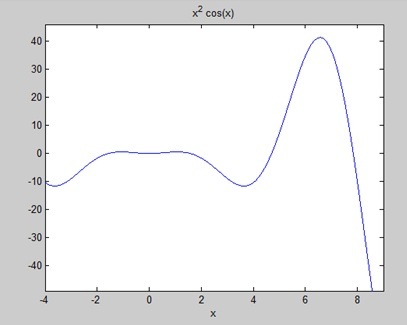- 教程
- 概述
- Environment Setup
- 语法
- 变量
- Commands
- M-Files
- 数据类型
- 运算符
- Decisions
- 循环
- Vectors
- Matrix
- Arrays
- Colon Notation
- Numbers
- Strings
- Functions
- Data Import
- Data Output
- Plotting
- Graphics
- Algebra
- Calculus
- Differential
- Integration
- Polynomials
- Transforms
- GNU Octave
- Simulink
- 有用的资源
- 讨论
- Show 例子 1
- Show 例子 2
- Show 例子 3
- Show 例子 4
- Show 例子 5
- if ... end statement
- if...else...end statement
- if...elseif...else statement
- 嵌套 if 语句(nested if statements)
- switch statement
- 嵌套的 switch 语句(nested switch statements)
- while 循环
- for 循环
- nested 循环
- break statement
- continue statement
- 载体的加法和减法(Addition and Subtraction of Vectors)
- 向量的标量乘法(Scalar Multiplication of Vectors)
- 矢量的转置(Transpose of a Vector)
- 附加向量(Appending Vectors)
- 矢量的大小(Magnitude of a Vector)
- 矢量点产品(Vector Dot Product)
- Vectors with Uniformly Spaced Elements
- 矩阵的加法和减法(Addition and Subtraction of Matrices)
- 矩阵划分(Division of Matrices)
- 矩阵的标量运算(Scalar Operations of Matrices)
- 矩阵的转置(Transpose of a Matrix)
- 连接矩阵(Concatenating Matrices)
- 矩阵乘法(Matrix Multiplication)
- 矩阵的行列式(Determinant of a Matrix)
- 逆矩阵(Inverse of a Matrix)
Integration
集成处理两种本质上不同类型的问题。
在第一种类型中,给出了函数的导数,我们想要找到函数。 因此,我们基本上扭转了分化的过程。 这种逆过程被称为反微分,或找到原始函数,或找到indefinite integral 。
第二类问题涉及累加非常大量的非常小的数量,然后随着数量的大小接近零而采取限制,而术语的数量倾向于无穷大。 这个过程导致了definite integral的定义。
定义积分用于寻找面积,体积,重心,转动惯量,由力完成的工作以及许多其他应用。
使用MATLAB查找不定积分
根据定义,如果函数f(x)的导数是f'(x),那么我们说f'(x)相对于x的不定积分是f(x)。 例如,由于x 2的导数(相对于x)是2x,我们可以说2x的不定积分是x 2 。
符号 -
f'(x 2 ) = 2x ,因此,
∫ 2xdx = x 2 .
不定积分不是唯一的,因为对于任何常数c的值,x 2 + c的导数也将是2x。
这用符号表示为 -
∫ 2xdx = x 2 + c 。
其中,c称为“任意常数”。
MATLAB提供了一个用于计算表达式积分的int命令。 为了得到一个函数的不定积分的表达式,我们写 -
int(f);
例如,从我们之前的例子 -
syms x
int(2*x)
MATLAB执行上述语句并返回以下结果 -
ans =
x^2
例子1 (Example 1)
在这个例子中,让我们找到一些常用表达式的积分。 创建一个脚本文件并在其中键入以下代码 -
syms x n
int(sym(x^n))
f = 'sin(n*t)'
int(sym(f))
syms a t
int(a*cos(pi*t))
int(a^x)
运行该文件时,它显示以下结果 -
ans =
piecewise([n == -1, log(x)], [n ~= -1, x^(n + 1)/(n + 1)])
f =
sin(n*t)
ans =
-cos(n*t)/n
ans =
(a*sin(pi*t))/pi
ans =
a^x/log(a)
例子2 (Example 2)
创建一个脚本文件并在其中键入以下代码 -
syms x n
int(cos(x))
int(exp(x))
int(log(x))
int(x^-1)
int(x^5*cos(5*x))
pretty(int(x^5*cos(5*x)))
int(x^-5)
int(sec(x)^2)
pretty(int(1 - 10*x + 9 * x^2))
int((3 + 5*x -6*x^2 - 7*x^3)/2*x^2)
pretty(int((3 + 5*x -6*x^2 - 7*x^3)/2*x^2))
请注意, pretty函数以更易读的格式返回表达式。
运行该文件时,它显示以下结果 -
ans =
sin(x)
ans =
exp(x)
ans =
x*(log(x) - 1)
ans =
log(x)
ans =
(24*cos(5*x))/3125 + (24*x*sin(5*x))/625 - (12*x^2*cos(5*x))/125 + (x^4*cos(5*x))/5 - (4*x^3*sin(5*x))/25 + (x^5*sin(5*x))/5
2 4
24 cos(5 x) 24 x sin(5 x) 12 x cos(5 x) x cos(5 x)
----------- + ------------- - -------------- + ------------
3125 625 125 5
3 5
4 x sin(5 x) x sin(5 x)
------------- + -----------
25 5
ans =
-1/(4*x^4)
ans =
tan(x)
2
x (3 x - 5 x + 1)
ans =
- (7*x^6)/12 - (3*x^5)/5 + (5*x^4)/8 + x^3/2
6 5 4 3
7 x 3 x 5 x x
- ---- - ---- + ---- + --
12 5 8 2
使用MATLAB查找定积分
根据定义,定积分基本上是总和的极限。 我们使用定积分来找到诸如曲线和x轴之间的区域以及两条曲线之间的区域之类的区域。 定义积分也可用于其他情况,其中所需数量可表示为总和的极限。
通过传递要计算积分的限制, int函数可用于定积分。
计算

我们写,
int(x, a, b)
例如,要计算值  我们写 -
我们写 -
int(x, 4, 9)
MATLAB执行上述语句并返回以下结果 -
ans =
65/2
以下是Octave相当于上面的计算 -
pkg load symbolic
symbols
x = sym("x");
f = x;
c = [1, 0];
integral = polyint(c);
a = polyval(integral, 9) - polyval(integral, 4);
display('Area: '), disp(double(a));
Octave执行代码并返回以下结果 -
Area:
32.500
可以使用Octave提供的quad()函数给出替代解决方案,如下所示 -
pkg load symbolic
symbols
f = inline("x");
[a, ierror, nfneval] = quad(f, 4, 9);
display('Area: '), disp(double(a));
Octave执行代码并返回以下结果 -
Area:
32.500
例子1 (Example 1)
让我们计算在x轴和曲线y = x 3 -2x + 5之间的区域,并且纵坐标x = 1和x = 2。
所需面积由 - 给出 -

创建一个脚本文件并键入以下代码 -
f = x^3 - 2*x +5;
a = int(f, 1, 2)
display('Area: '), disp(double(a));
运行该文件时,它显示以下结果 -
a =
23/4
Area:
5.7500
以下是Octave相当于上面的计算 -
pkg load symbolic
symbols
x = sym("x");
f = x^3 - 2*x +5;
c = [1, 0, -2, 5];
integral = polyint(c);
a = polyval(integral, 2) - polyval(integral, 1);
display('Area: '), disp(double(a));
Octave执行代码并返回以下结果 -
Area:
5.7500
可以使用Octave提供的quad()函数给出替代解决方案,如下所示 -
pkg load symbolic
symbols
x = sym("x");
f = inline("x^3 - 2*x +5");
[a, ierror, nfneval] = quad(f, 1, 2);
display('Area: '), disp(double(a));
Octave执行代码并返回以下结果 -
Area:
5.7500
例子2 (Example 2)
求出曲线下面积:f(x)= x 2 cos(x)-4≤x≤9。
创建一个脚本文件并编写以下代码 -
f = x^2*cos(x);
ezplot(f, [-4,9])
a = int(f, -4, 9)
disp('Area: '), disp(double(a));
运行该文件时,MATLAB绘制图形 -

输出如下 -
a =
8*cos(4) + 18*cos(9) + 14*sin(4) + 79*sin(9)
Area:
0.3326
以下是Octave相当于上面的计算 -
pkg load symbolic
symbols
x = sym("x");
f = inline("x^2*cos(x)");
ezplot(f, [-4,9])
print -deps graph.eps
[a, ierror, nfneval] = quad(f, -4, 9);
display('Area: '), disp(double(a));
如果你对这篇内容有疑问,欢迎到本站社区发帖提问 参与讨论,获取更多帮助,或者扫码二维码加入 Web 技术交流群。

绑定邮箱获取回复消息
由于您还没有绑定你的真实邮箱,如果其他用户或者作者回复了您的评论,将不能在第一时间通知您!
发布评论